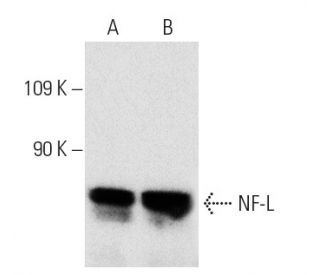
NF-L Antikörper (8A1): sc-20012
- NF-L Antikörper (8A1) ist ein Maus monoklonales IgG1 κ, verwendet in 28 wissenschaftlichen Veröffentlichungen, in einer Menge von 200 µg/ml
- gegen aus human Gehirn gereinigtes Neurofilament
- Anti-NF-L Antikörper (8A1) ist empfohlen für die Detektion von NF-L aus der Spezies mouse, rat und human per WB, IP, IF und IHC(P)
- Anti-NF-L Antikörper (8A1) ist erhältlich als Konjugat mit Agarose für IP; HRP für WB, IHC(P) und ELISA; und entweder mit Phycoerythrin oder FITC für IF, IHC(P) und FCM
- auch erhältlich als Konjugat mit Alexa Fluor® 488, Alexa Fluor® 546, Alexa Fluor® 594 oder Alexa Fluor® 647 für IF, IHC(P) und FCM
- auch erhältlich als Konjugat mit Alexa Fluor® 680 oder Alexa Fluor® 790 für WB (NIR), IF und FCM
- 1 BP-HRP">m-IgG1 BP-HRP und m-IgGκ BP-HRP sind die bevorzugten sekundären Nachweisreagenzien für NF-L Antikörper (8A1) für WB- und IHC(P)-Anwendungen. Diese Reagenzien werden jetzt in Bündeln mit NF-L Antikörper (8A1) angeboten(siehe Bestellinformationen unten).
Direktverknüpfungen
Der NF-L-Antikörper (8A1) ist ein monoklonaler IgG1-Kappa-Leichtketten-Antikörper der Maus, der NF-L von Mäusen, Ratten und Menschen durch Western Blot (WB), Immunpräzipitation (IP), Immunfluoreszenz (IF) und Immunhistochemie nachweist. Der NF-L (8A1)-Antikörper ist sowohl in nicht konjugierter als auch in verschiedenen konjugierten Formen erhältlich, darunter Agarose, Meerrettichperoxidase (HRP), Phycoerythrin (PE), Fluoresceinisothiocyanat (FITC) und mehrere Alexa Fluor®-Konjugate. Neurofilament-L (NF-L) oder Neurofilament-Leicht-Polypeptid ist ein entscheidender Bestandteil des neuronalen Zytoskeletts und spielt eine wichtige Rolle bei der Aufrechterhaltung der strukturellen Integrität von Neuronen. NF-L befindet sich hauptsächlich in den Axonen von Neuronen und trägt zur Regulierung des Axonkalibers bei, was für eine ordnungsgemäße Nervensignalleitung unerlässlich ist. Die dynamische Natur der Neurofilamente ermöglicht es ihnen, mit anderen Zytoskelettelementen wie Mikrotubuli und Aktinfilamenten zu interagieren und so die allgemeine neuronale Funktion und Stabilität zu beeinflussen. Wichtig ist, dass Veränderungen der NF-L-Phosphorylierung und des NF-L-Metabolismus häufig mit neurodegenerativen Erkrankungen wie amyotropher Lateralsklerose (ALS), Parkinson und Alzheimer in Verbindung gebracht werden, was NF-L zu einem wertvollen Biomarker für die Erforschung dieser Erkrankungen macht.
Alexa Fluor® ist ein Markenzeichen von Molecular Probes Inc., OR., USA
LI-COR® und Odyssey® sind Markenzeichen von LI-COR Biosciences
NF-L Antikörper (8A1) Literaturhinweise:
- Casein-Kinase II ist für die Phosphorylierung von NF-L an Ser-473 verantwortlich. | Nakamura, Y., et al. 1999. FEBS Lett. 455: 83-6. PMID: 10428477
- Neurofilament-Stoffwechsel bei sporadischer amyotropher Lateralsklerose. | Strong, MJ. 1999. J Neurol Sci. 169: 170-7. PMID: 10540027
- Auswirkungen der Phosphorylierung des Neurofilament-L-Proteins auf filamentöse Strukturen. | Hisanaga, S., et al. 1990. Cell Regul. 1: 237-48. PMID: 2100199
- Die Beteiligung der Proteinkinase C an der Regulierung des Auf- und Abbaus von Neurofilamenten in vitro. | Gonda, Y., et al. 1990. Biochem Biophys Res Commun. 167: 1316-25. PMID: 2108674
- An der In-vivo-Phosphorylierung verschiedener Domänen der 70-Kilodalton-Untereinheit des Neurofilaments sind unterschiedliche Proteinkinasen beteiligt. | Sihag, RK. and Nixon, RA. 1989. J Biol Chem. 264: 457-64. PMID: 2491851
- Aufbau und Austausch von Intermediärfilamentproteinen von Neuronen: Neurofilamente sind dynamische Strukturen. | Angelides, KJ., et al. 1989. J Cell Biol. 108: 1495-506. PMID: 2925792
- Erhöhte NF-L-Werte im TDP-43G298S ALS-Mausmodell ähneln den NF-L-Werten bei ALS-Patienten. | Buck, E., et al. 2022. Acta Neuropathol. 144: 161-164. PMID: 35585288
- Plasma Neurofilament Light Chain (NF-L) ist ein prognostischer Biomarker für die Entwicklung kortikaler Schäden, aber nicht für kognitive Beeinträchtigungen oder Epileptogenese nach experimentellen Schädel-Hirn-Traumata. | Heiskanen, M., et al. 2022. Int J Mol Sci. 23: PMID: 36499527
- Neurofilament-Leichtketten (NF-L), ein Biomarker für neuronale Schäden, ist bei Patienten mit schwerer Sarkopenie erhöht: Ergebnisse der SarcoPhAge-Studie. | Ladang, A., et al. 2023. Aging Clin Exp Res. 35: 2029-2037. PMID: 37581861
- Verlauf der Liquor- und Plasmabiomarker über das Kontinuum der Alzheimer-Krankheit: Krankheitsstadium anhand von NF-L, p-tau181 und GFAP. | Wojdała, AL., et al. 2023. Neurobiol Dis. 189: 106356. PMID: 37977432
- Abnorme Verteilung von Neurofilament L in Neuronen mit Alzheimer-Krankheit. | Nakamura, Y., et al. 1997. Neurosci Lett. 225: 201-4. PMID: 9147405
- Studien zum Gen-Targeting beginnen, die Funktion der Neurofilament-Proteine zu enthüllen. | Hirokawa, N. and Takeda, S. 1998. J Cell Biol. 143: 1-4. PMID: 9763415
Bestellinformation
| Produkt | Katalog # | EINHEIT | Preis | ANZAHL | Favoriten | |
NF-L Antikörper (8A1) | sc-20012 | 200 µg/ml | RMB2377.00 | |||
NF-L (8A1): m-IgGκ BP-HRP Bundle | sc-520704 | 200 µg Ab, 40 µg BP | RMB2662.00 | |||
NF-L (8A1): m-IgG1 BP-HRP Bundle | sc-551250 | 200 µg Ab; 20 µg BP | RMB2662.00 | |||
NF-L Antikörper (8A1) AC | sc-20012 AC | 500 µg/ml, 25% agarose | RMB3129.00 | |||
NF-L Antikörper (8A1) HRP | sc-20012 HRP | 200 µg/ml | RMB2377.00 | |||
NF-L Antikörper (8A1) FITC | sc-20012 FITC | 200 µg/ml | RMB2482.00 | |||
NF-L Antikörper (8A1) PE | sc-20012 PE | 200 µg/ml | RMB2580.00 | |||
NF-L Antikörper (8A1) Alexa Fluor® 488 | sc-20012 AF488 | 200 µg/ml | RMB2685.00 | |||
NF-L Antikörper (8A1) Alexa Fluor® 546 | sc-20012 AF546 | 200 µg/ml | RMB2685.00 | |||
NF-L Antikörper (8A1) Alexa Fluor® 594 | sc-20012 AF594 | 200 µg/ml | RMB2685.00 | |||
NF-L Antikörper (8A1) Alexa Fluor® 647 | sc-20012 AF647 | 200 µg/ml | RMB2685.00 | |||
NF-L Antikörper (8A1) Alexa Fluor® 680 | sc-20012 AF680 | 200 µg/ml | RMB2685.00 | |||
NF-L Antikörper (8A1) Alexa Fluor® 790 | sc-20012 AF790 | 200 µg/ml | RMB2685.00 |
